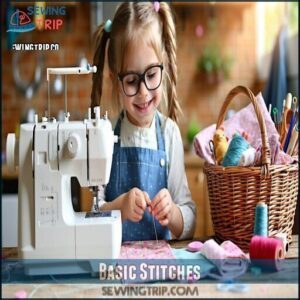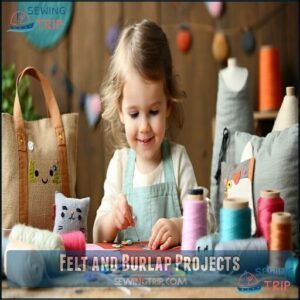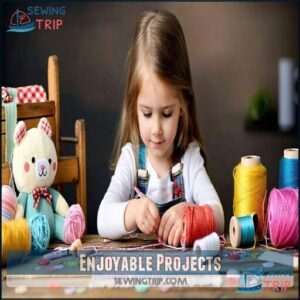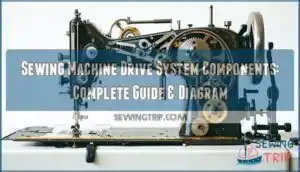This site is supported by our readers. We may earn a commission, at no cost to you, if you purchase through links.
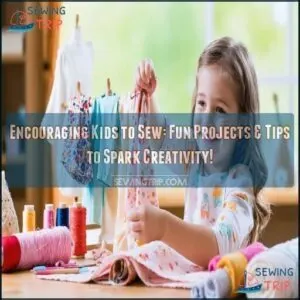 Encouraging kids to sew is all about keeping it fun and pressure-free.
Encouraging kids to sew is all about keeping it fun and pressure-free.
Start by sparking their interest—maybe show them how sewing can create cool things like scrunchies, pillows, or even costumes.
Let them pick their fabrics and projects because ownership makes it exciting.
Use real but age-appropriate tools, like blunt needles or slower sewing machines, to keep things safe.
Teach basic hand stitches on forgiving materials like felt or burlap—mistakes don’t stand a chance here.
Celebrate every effort, no matter how wobbly their stitches look, because growth comes with practice and makes a sewing superstar.
Table Of Contents
Key Takeaways
- Let kids choose their projects and fabrics to spark their excitement and sense of ownership.
- Start with safe, age-appropriate tools and simple materials like felt or burlap to build confidence.
- Emphasize praise for effort and creativity, focusing on growth and fun over perfection.
- Teach basic stitches like the running stitch or whipstitch through easy, beginner-friendly projects.
Encourage Their Interests
Spark your child’s sewing journey by diving into their creative world.
Explore their favorite colors, patterns, and design ideas together, turning curiosity into a fun skill-building adventure.
Let them choose exciting projects like vibrant pillows or quirky felt animals that match their personal style.
Join local kids’ sewing communities for fresh inspiration and support.
By nurturing their interests and providing gentle guidance, you’ll transform sewing from a simple hobby into an exciting pathway of creative freedom.
Turn sewing into a joyful journey of creativity, where every stitch unlocks endless possibilities and builds unstoppable confidence.
Embrace their unique vision and watch their confidence soar with every stitch.
Encourage them to follow proper safety guidelines to guarantee a fun and safe sewing experience.
Praise Their Efforts
Your child’s sewing journey is all about growth, not getting everything perfect on the first try.
By showering them with genuine praise and focusing on their effort and creativity, you’ll help build their confidence and keep them excited about learning this awesome skill.
Celebrate Progress, Not Perfection
As you inspire young sewists, remember that learning is a journey, not a destination.
Embrace their unique sewing path with open arms and a supportive heart:
- Cheer every wobbly stitch
- Celebrate small victories
- Embrace imperfect creations
- Nurture their creative spirit
- Watch confidence bloom
Each uneven seam tells a story of growth, patience, and the beautiful messiness of learning something new, showcasing the importance of a supportive heart.
Avoid Criticism
When nurturing young sewists, ditch the harsh critique. Your words can build or break their confidence. Instead, offer gentle guidance that turns mistakes into learning opportunities. By focusing on techniques to hide sewing mistakes, you can help them develop a growth mindset.
Celebrate each stitch, no matter how imperfect. Remember, every wobbly line is a step toward mastery.
| Approach | Impact |
|---|---|
| Harsh Criticism | Discourages Future Attempts |
| Positive Feedback | Builds Sewing Confidence |
| Error Tolerance | Encourages Creativity |
| Constructive Comments | Supports Skill Growth |
By adopting a supportive approach, you can foster an environment where young sewists feel encouraged to try new things, learn from their mistakes, and develop a love for sewing that will last a lifetime, ultimately leading to sewing confidence.
Let Them Choose Projects
In the context of sewing, giving kids the power to choose their own projects is like handing them a creative magic wand.
By letting them pick designs that spark their imagination, you’ll watch their enthusiasm soar and their confidence bloom faster than a speedy sewing machine can stitch a seam, which is a truly magical experience.
Personal Project Selection
Imagination takes flight when kids choose their sewing adventures! Give them the creative reins with these project ideas:
- Cuddly plush animal companions
- Personalized accessory crafting
- Mini decorative pillows
- Beginner-friendly sewing kits
- Unique fabric exploration zones
Empowering children to select their sewing projects transforms learning into a fun, skill-building experience. By offering diverse fabric choices and supporting their vision, you’ll ignite their passion for creating something truly magical with their own hands.
This approach allows kids to have complete control over their projects, fostering a sense of ownership and creativity.
Enhancing Motivation
When diving into sewing, harness kids’ motivation through clever reward systems that transform learning into an adventure.
Offer exciting perks like movie nights or special treats after completing projects.
Create a buddy system where friends join in, making sewing a social experience that builds confidence and keeps children enthusiastic to learn and grow, with clever reward systems.
Encouraging Creativity
Discover your inner artist through sewing! By giving kids the reins to their creative journey, you’ll transform simple fabric into magical worlds of personal expression.
Let their imagination run wild with projects that speak directly to their passions:
- Craft a beloved cartoon character plushie
- Design quirky, bold accessories
- Create whimsical room decorations
- Invent unique stuffed animal companions
- Build imaginative storytelling props
Using sewing projects for kids helps develop essential skills and fosters creativity through sewing basic kits.
Provide Quality Tools
Don’t skimp on the tools—good-quality needles, thread, and scissors make all the difference.
Using real, age-appropriate tools teaches safety as well as helps kids feel like confident, capable creators.
Real Tools, Not Toys
Giving kids real tools, not flimsy toys, builds confidence and makes sewing more rewarding.
Sharp needles, good thread, and kid-friendly scissors guarantee a smoother experience while fostering proper skills.
Skip plastic playsets—invest in quality sewing kits with durable items.
Teaching kids to sew with real tools prepares them for future projects and highlights the importance of fabric quality and tool safety.
With the right resources, sewing for kids feels professional and fun.
Using authentic sewing tools, such as those found in real sewing tools kits, helps develop essential skills for young sewers to master basic sewing techniques.
Age-Appropriate Tools
To get the best out of sewing with kids, make sure their tools match their age and skill level.
Start with blunt sewing needles, soft felt fabric, and kid tools like safety scissors. As confidence grows, upgrade to sharper sewing needles and even a basic sewing machine for kids.
Here’s a quick list of must-haves:
- Sewing Kits: Choose ones with fun threads, kid scissors, and colorful tools.
- Sewing Safety Equipment: Safety clips and blunt tools prevent accidents.
- Fabric Selection: Felt and lightweight fabrics are great for easy stitching.
Using good quality tools is essential for a successful sewing experience.
Keep it fun and safe—happy sewing!
Start With Hand Sewing
Start with hand sewing to keep things simple and fun—it’s like drawing with thread.
Hand sewing is a simple, joyful way to create—like drawing pictures, but with colorful thread and fabric!
Show them a few basic stitches, and soon they’ll be creating little treasures with their own hands.
Basic Stitches
Learning basic stitches is the first step to mastering sewing for kids! Start with these:
- Running Stitch: Perfect for simple lines and quick projects.
- Backstitch: Strong and decorative for detailed work.
- Whipstitch: Secures fabric edges neatly.
- Embroidery: Adds creative flair to personal designs.
These beginner sewing stitches build confidence and teach thread control while keeping it fun.
Felt and Burlap Projects
Felt crafts and burlap bags are fantastic for beginner sewing projects! These materials are sturdy and easy to handle, making them perfect for little hands.
Try sewing tiny pillows or quirky stuffies, then jazz them up with buttons or fabric painting. Felt sewing projects can even turn into beautiful textile art.
Simplify the process with sewing kits for kids—they’re a lifesaver. Handsewing projects like these make sewing for kids both fun and rewarding!
For a great start, examine using felt sewing kits to explore various project options.
Make It Fun and Engaging
Keep sewing fun by choosing projects that match your child’s interests—you’ll be amazed at how much more excited they’ll get.
Whether it’s stitching a superhero cape or decorating a pillow, let their creativity lead the way!
Enjoyable Projects
Make sewing fun with colorful, easy projects kids will love! Start by exploring sewing games or simple fabric crafts like scrunchies, plush toys, or bookmarks.
Here’s a quick list of ideas:
- Use sewing kits for kids with fun patterns.
- Try beginner sewing projects like felt animals or pillows.
- Experiment with fun stitches on decorative fabrics.
Let their creativity shine—mistakes are just happy little accidents!
Incorporate Their Interests
Spark your child’s creativity by blending sewing with their interests.
Choose fabrics featuring superheroes, animals, or hobbies they love.
Create Kid Friendly Projects like sewing for toys or crafting personalized accessories.
Encourage Fabric Selection that reflects their Personal Style, giving them Creative Freedom.
Sewing with family can become a fun adventure, where sewing games ignite imagination and sewing becomes their way to express!
Foster Skill Development
When kids practice sewing regularly, they build confidence and improve their skills bit by bit.
Break projects into smaller steps and set simple goals—watching them succeed will make both of you smile!
Practice Regularly
Consistency is the secret sauce for building sewing skills! Regular practice makes sewing feel natural, like brushing your teeth—easy and part of everyday life.
Set up simple sewing schedules that fit your routine and stick to them. Keep it fun with a cozy, creativity-inspiring space.
- Try mini projects: Daily stitches on felt bookmarks or doll clothes keep it fresh.
- Rotate tasks: Alternate between hand-sewing basics and creative designs.
- Be flexible: Practice sessions don’t have to be perfect; they just need to happen.
With patience and persistence, sewing habits will grow, and confidence will bloom!
Break Down Tasks
Breaking sewing tasks into small steps is like untangling thread—less overwhelming for kids.
Focus on Task Segmentation and Step Guidance to make learning stages easy to grasp.
Use this simple table for planning:
| Step | Example | Tip |
|---|---|---|
| Measure Fabric | Cut felt for bookmarks | Use a ruler for precision. |
| Practice Stitches | Try running stitches | Guide their needle control. |
| Add Details | Sew on buttons or patches | Celebrate creative touches! |
Sewing basics build skill, confidence, and fun!
By following proper safety guidelines, kids can enjoy sewing while minimizing risks.
Set Realistic Goals
Teaching kids to sew is exciting when you set realistic goals. Start small:
- Learn one basic stitch.
- Finish fun, manageable projects like a felt bookmark.
- Celebrate each step to boost confidence—maybe stickers or special treats as achievement rewards.
- Use progress tracking to highlight improvements and skill levels.
Matching goals to their learning pace makes sewing enjoyable while building patience and focus.
Frequently Asked Questions (FAQs)
What age should kids start sewing?
Did you know kids as young as 5 can begin sewing with simple hand-stitching projects?
Start when they show curiosity and readiness, using kid-friendly tools like blunt needles.
Patience and fun are the magic ingredients!
How to teach a 7 year old to use a sewing machine?
Start with the basics—show them how to thread the needle and use the foot pedal.
Keep your cool, let them practice on scrap fabric, and praise their effort.
Mistakes? That’s just free learning!
How to teach someone to sew for beginners?
Sewing isn’t rocket science—it’s just some thread, a needle, and a bit of patience.
Start simple: practice straight stitches, use fabric scraps, and embrace wonky lines.
Mistakes? They’re just stepping stones to mastery.
How do I get motivated to sew?
Pick a simple project that excites you—a cute pillow or hemming your favorite jeans.
Set up a cozy workspace, play music you love, and remind yourself that progress, not perfection, is the goal.
At what age should you teach a child to sew?
Kids as young as 6 can start sewing, using blunt needles and felt.
By 8, many can handle sharper tools.
Follow their interest and readiness—it’s all about timing, not a universal “perfect age.”
How do you introduce kids to sew?
Get started by letting them play with fabric scraps and blunt needles.
Keep things simple—felt bookmarks or stuffed animals work great.
Add bright, fun fabrics, and cheer on every stitch, even if it’s wobbly!
Can you teach a 5 year old to sew?
Think of it like planting seeds in soft soil; a 5-year-old can start sewing with simple projects like felt shapes.
Use blunt needles, bright thread, and let creativity bloom—mistakes are just part of the fun!
Why teach kids to sew?
Teaching kids to sew sparks creativity, builds problem-solving skills, and boosts confidence.
It’s a fun, hands-on way to practice patience and fine motor skills while creating something meaningful.
Plus, you’ll inspire lifelong self-sufficiency and joy!
How do I teach my 7 year old to use a sewing machine?
Start slow with safety basics: show them how to place their fingers, use the foot pedal, and thread the needle.
Pick simple projects with straight lines and let them practice—mistakes are just learning steps!
At what age can children use a sewing machine?
Around 75% of kids, aged 8-10, feel excited when mastering hands-on skills.
Kids as young as 7 can start using sewing machines with supervision.
Just focus on safety, short lessons, and plenty of encouragement.
Conclusion
It’s funny how one small project can spark a lifelong love for sewing.
Encouraging kids to sew isn’t just about stitches; it’s about inspiring creativity, building confidence, and sharing in their excitement.
Let them choose what they love, make mistakes without worry, and celebrate every wobbly stitch along the way.
With the right tools, simple projects, and a bit of patience, you’ll help them create more than crafts—they’ll be sewing memories to last a lifetime.





